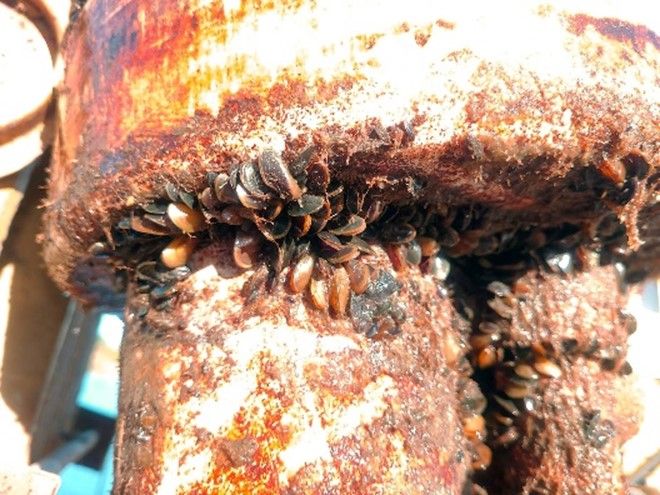Invasive Golden Mussel
The invasive Golden mussel (Limnoperna fortunei), a non-native freshwater/brackish bivalve, has been detected in the Sacramento - San Joaquin Delta - the first known occurrence of golden mussels in North America.
The species poses a significant immediate threat to the natural ecosystems, water infrastructure and water quality. (Right, invasive mussels attached to water infrastructure. Source: California Department of Fish and Wildlife).
The mussel has not been detected in EBMUD reservoirs. To prevent spread, all boat launches are closed until further notice.
EBMUD and other water managers are working with CDFW to routinely update a map of locations where this mussel has been detected. View the map here.
In response to the recent discovery of Golden Mussels within the Delta, EBMUD has suspended boat launch activities and is developing a comprehensive plan to protect its fisheries, recreational facilities, and power & water supply infrastructure. The plan will include:
- Measures to reduce risks associated with boats;
- Increased water sampling within the reservoirs;
- Other operational changes to minimize the risk of a mussel infestation.
CDFW advises the following regarding the Golden Mussel:
Golden mussel (Limnoperna fortunei) is an invasive bivalve
that ranges in color from dark brown to gold. It can reach up
to 1 ¾ inches long. Adult mussels form byssal threads that
enable them to attach to surfaces. Adult mussels spawn
multiple times each year and have the potential to produce
thousands of planktonic offspring, called veligers.
Golden Mussels are similar to quagga and zebra mussels; they are invasive and proliferate quickly - but the Golden Mussel can thrive in a greater variety of conditions including waters with lower calcium levels, making them an even more significant concern.
In October 2024, golden mussels were discovered in the
Sacramento – San Joaquin Delta and O’Neill Forebay (Merced County). This discovery was the first known occurrence of golden mussel in North America. Originally from China and Southeast Asia, they have invaded waters of Japan, Taiwan, Brazil, Uruguay, Paraguay, Bolivia, and Argentina.
Golden mussel can inhabit fresh and brackish-water lakes, rivers, creeks, wetlands, bays, and canals with water temperatures ranging from 41-95°F. They can establish in waters with a constant salinity of less than 3 parts per thousand (ppt) and can survive fluctuations of higher salinities. They attach to a wide variety of substrates, both man-made and natural, and at various water depths. Golden mussels are not restricted to hard surfaces and have been found colonizing soft substrates and attached to aquatic plants.
Pathways are the mechanisms and processes by which invasive species are moved, intentionally or unintentionally, into a new ecosystem. Golden mussel can be carried in ballast water of ocean-going ships and released with that water. Adult golden mussel can be moved overland attached to watercraft and in-water equipment, and veligers and adults can be moved overland in water contained within watercraft and equipment. Within interconnected waters, golden mussels can expand their range via the flow of water, and attached to, or entrapped within, watercraft and in-water structures moved within that waterways.
Golden mussels are highly efficient filter feeders and form dense colonies. They consume large quantities of aquatic microscopic plants and animals that native species and sport fish depend on for food. Their colonization of hard surfaces impedes water flow, clogs pipes, and fouls watercraft motors,
and necessitates ongoing, costly removal to maintain operational function. These costs result in economic impacts to water conveyances, energy production, recreation, agriculture, and ultimately the public.
If you observe golden mussel in California immediately report your sighting to the CDFW Invasive Species Program at https://arcg.is/10D4G8, or by email to Invasives@wildlife.ca.gov, or by telephone to (866) 440-9530. Please take clear, close-up photos that include something (such as a pencil or hand) to show size.
Related Links
- CDFW resources page for Quagga and Zebra Mussels
- US Geological Survey's Quagga and Zebra Mussel Resource Webpage
- Golden Mussel Fact Sheet
Additional Information
| Document | Type | Size |
|---|---|---|
| Boat Inspection Form | <1 MB | |
| Quagga Map | <1 MB |